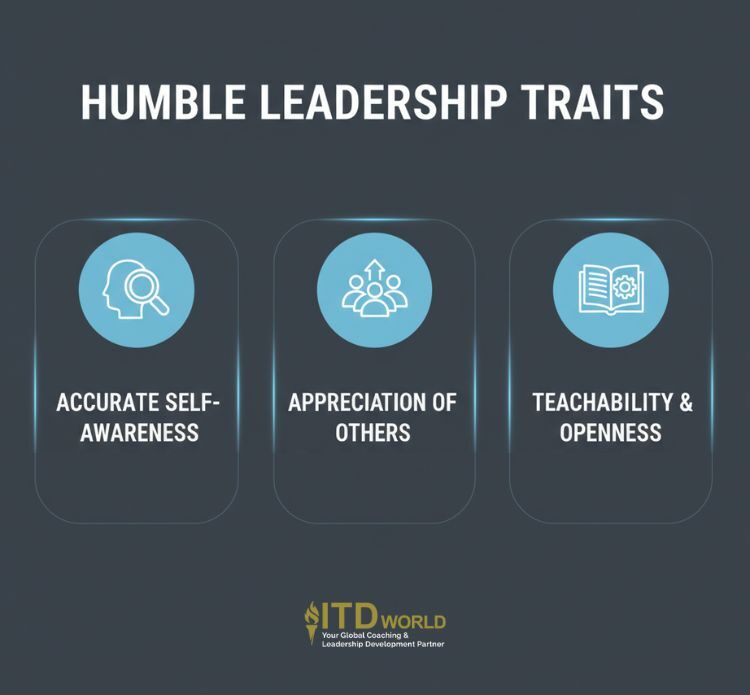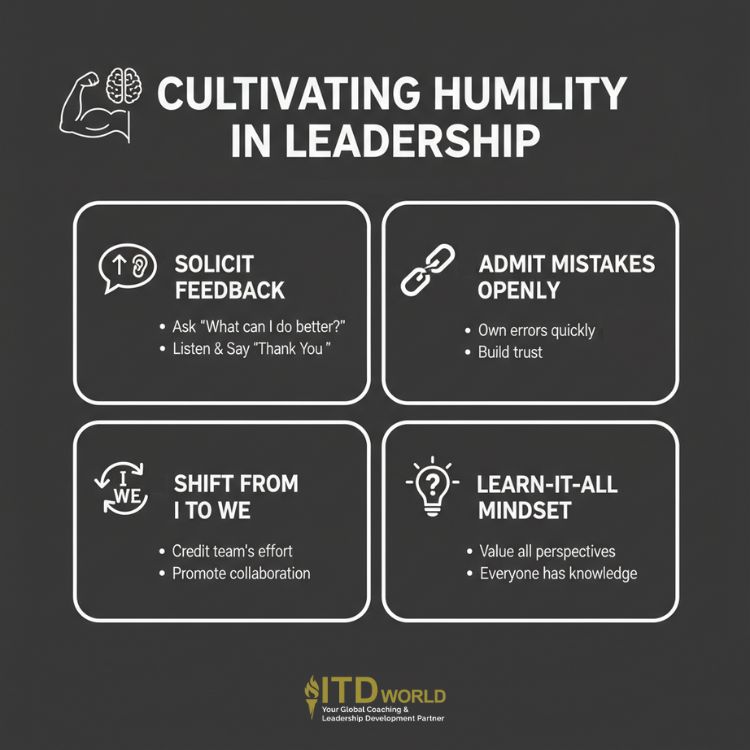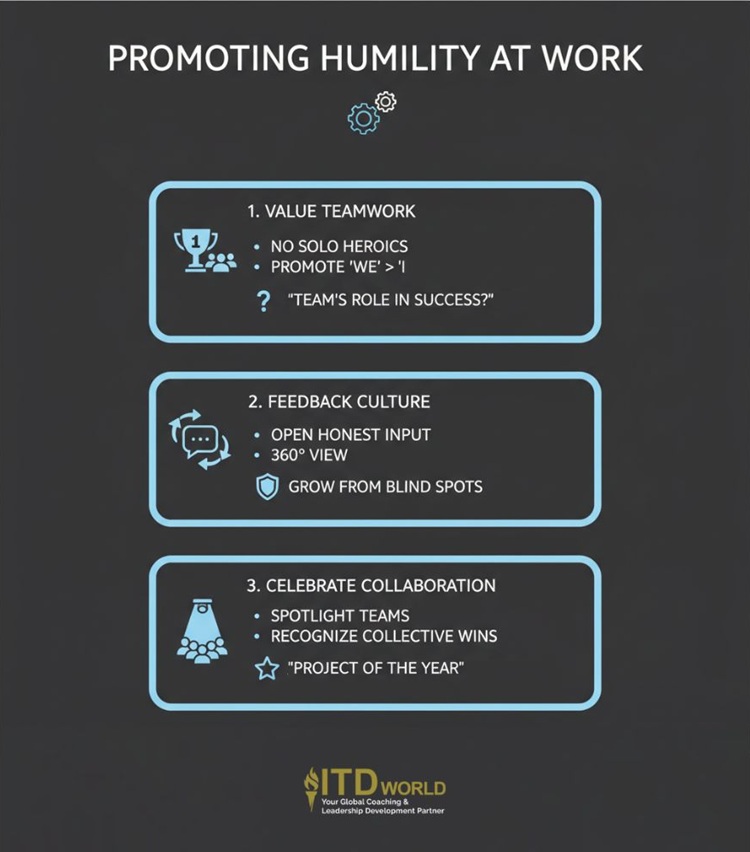An overview of humble leadership, including its core characteristics, proven impact on performance, plus actionable steps for cultivating it.
An unchecked ego is one of the greatest liabilities in business – it creates blind spots, silences innovation, and puts a hard ceiling on a team’s potential for growth. The strategic antidote is humble leadership – not an absence of confidence, but the presence of a powerful self-awareness that allows a leader to learn, adapt, and unlock the full intelligence of their people.
(by Jonathan M. Pham)
Highlights
- Humble leadership is a management approach characterized by an accurate understanding of one’s own strengths and weaknesses, a strong appreciation for the contributions of others, and a genuine openness to learning. It is a powerful and practical strategy that fosters a learning culture, increases employee engagement, promotes psychological safety, and ultimately improves overall team performance by encouraging open communication, valuing diverse perspectives, and empowering team members.
- The main challenges to humble leadership include the prevailing “heroic leader” stereotype, the ego that can develop from personal success, and the common misconception of humility as a weakness rather than a strength.
- Practicing humility in leadership involves actively seeking and listening to feedback, openly admitting mistakes, shifting language from “I” to “we” to acknowledge team contributions, and embracing a “learn-it-all” mindset that values all perspectives.
- To normalize humility in the workplace, organizations should update promotion criteria to favor collaborative leaders, establish robust feedback systems like 360-degree reviews, and celebrate collective achievements over individual “heroics.”
What is Humble Leadership?
Humble leadership is a management style where an individual demonstrates an accurate, grounded understanding of their own strengths and weaknesses, a deep appreciation for the contributions of others, and an open-minded willingness to learn. It is not about thinking less of yourself, but “thinking about yourself less”. It is a learnable mindset that counters the business liability of an unchecked ego, creating an environment where the best ideas – not just those of the leader only – may shine.
Core characteristics:
- Accurate self-awareness: Humble leaders see themselves clearly. They are confident enough to acknowledge their limitations and are comfortable not having all the answers. Their coachable attitude prevents the defensiveness that often stifles new ideas.
- Appreciation of others: They actively look for and celebrate the skills and talents of their team members – knowing that their success is dependent on the collective intelligence of the group – and are quick to give credit where it is due.
- Teachability & openness: A humble leader is typically known for their genuine desire to learn and adapt. They are open to new information and feedback, regardless of its source.
A powerful modern example is Satya Nadella, CEO of Microsoft. When he took the helm in 2014, he is widely credited with shifting the company’s internal culture from a competitive, “know-it-all” environment to a more collaborative, “learn-it-all” culture. This shift, rooted in his own humble and empathetic approach, prioritized listening and learning from customers, partners, and employees, and has been central to Microsoft’s extraordinary resurgence and innovation.

Humble Leadership vs Servant Leadership
While these two leadership styles are closely related and often coexist in the same person, they have different starting points and primary focuses.
| Aspect | Humble Leadership |
Servant Leadership
|
| Primary Focus | An accurate view of oneself in relation to others. |
The needs and growth of others.
|
| Core Question | “What can I learn from my team to achieve our goal?” |
“How can I help my team achieve their goal?”
|
| Leader’s Role | Lead Learner and Facilitator of ideas. |
Steward and Supporter of people.
|
| Main Outcome | A learning culture, psychological safety, and innovation. |
Team well-being, personal growth, and high trust.
|
In essence, a servant leader is primarily driven by a motive to serve, while a humble one operates from a mindset of self-awareness. The most effective modern leaders tend to embody both qualities, creating a powerful combination of support and continuous improvement.

Humble leadership style
The Importance of Humility in Leadership
Humility is the cornerstone of leadership.
John G. Miller
While humility is a virtue, in today’s competitive business world, it is also a powerful and pragmatic strategy. The common misconception of a leader as an infallible, heroic figure is being replaced by a data-driven understanding that a leader’s humility is a key catalyst for team success.
- Fosters a learning culture
Humble leaders are willing to admit that they do not have all the answers. Their openness makes them more receptive to new ideas and feedback – which, in turn, encourages team members to speak up and experiment without fear of reprisal. That dynamic is the engine of organizational learning and innovation.
According to research published in the Journal of Management, humble leadership is positively associated with a team’s ability to share information, learn from mistakes, and come up with novel ideas. When a leader models teachability, the entire team is more likely to embrace a learning mindset as a result.
- Increases employee engagement & psychological safety
Humility is a cornerstone of an inclusive work environment. A landmark study by Catalyst, a global non-profit, revealed that when employees perceive their leaders as humble, they report a greater sense of inclusion. This feeling of being valued and safe is a primary driver of engagement and a key factor in retaining top talent.
- Improves overall team performance
The combination of learning and engagement translates directly to better results. Studies have shown that humble leaders are more effective at getting their teams to align on a common purpose and collaborate efficiently. Because they empower others and allow the best ideas to rise to the top, their teams tend to consistently outperform those led by more ego-driven managers.
The strategic wisdom of humble leadership is not just a modern discovery. Think about those like Abraham Lincoln, who, during a time of national crisis, famously assembled a “team of rivals” – a cabinet filled with his political opponents and strongest critics. Lincoln possessed immense self-confidence, but he also recognized that he did not have all the answers. As such, he understood that the diverse, and often conflicting, perspectives of his rivals were essential for making the best possible decisions for the nation.
Why humility in leadership matters TED Talks
Challenges of Humble Leadership
- The “heroic leader” stereotype
For decades, our cultural image of a “strong” leader has been dominated by the stereotype of the bold, charismatic, and infallible hero – a visionary who has all the answers and single-handedly guides the organization to victory. This archetype, celebrated in business media and popular culture, presents humility as the antithesis of decisive leadership.
The impact: Organizations often inadvertently select and promote individuals who fit this confident, assertive mold. In doing so, they risk overlooking quieter, more inquisitive candidates who possess the humble qualities that are actually more suitable for building collaborative and innovative teams in the long run.
- The ego trap of success
A leader’s own success may turn out to be the biggest barrier to humility. As an individual rises through the ranks, they are praised and rewarded for their expertise and correct decisions. This continuous positive reinforcement builds up an ego that makes it psychologically difficult to do three things:
-
- Admit you don’t have the answer.
- Concede that a subordinate might have a better idea.
- Acknowledge a mistake.
Example: A star software developer who is promoted to engineering manager may struggle to let their team code in their own way. Their ego, built upon their own proven success as a developer, makes it difficult to accept that other creative approaches might also be effective, leading them to micromanage instead of empower.
- The misconception of humility as weakness
This is the most fundamental and pervasive barrier. For many people, the word “humility” is incorrectly equated with being passive, timid, or lacking in confidence. This misunderstanding prevents leaders from ever aspiring to it.
It’s crucial to distinguish between the two:
-
- False modesty is a sign of insecurity – pretending to be less than you are.
- True humility is a sign of strength and confidence. It is the ability to acquire an accurate, grounded view of your own capabilities – including your limitations – without defensiveness. It takes immense self-assurance to be open about what you don’t know and to genuinely celebrate the strengths of others.
The above-mentioned forces – cultural stereotypes, the psychological effects of success, and a fundamental misunderstanding of the concept – combine to make humble leadership a rare commodity. Yet, precisely because it is so rare, it is also a source of significant competitive advantage for those who are intentional about cultivating it.

How to Cultivate Humility in Leadership
Humility is like a muscle; it grows stronger with regular exercise. This “workout” consists of forming new habits that challenge the ego and prioritize learning and collaboration.
-
Actively solicit feedback – and truly listen
Humble leaders do not wait for the annual performance review to get to know about their impact. Rather, they actively seek input, and more importantly, they listen to it without becoming defensive.
Technique: Instead of asking a generic question like, “How am I doing?”, try something more specific, forward-looking like, “What is one thing I could start doing in our team meetings to make them work better for you?” When you receive the feedback, your first response should always be, “Thank you for sharing that with me,” even if it’s difficult to hear. Doing so signals that you value the idea and makes it safe for people to be honest in the future.
Read more: Gratitude in the Workplace – A Reflection on Its Miraculous Power
-
Admit mistakes openly
Modeling vulnerability is one of the most powerful ways to promote trust and psychological safety. When you make an error, no matter how small, own it quickly and publicly.
Example: A simple statement like, “I apologize, I gave the team the wrong data set for that analysis. That’s my mistake, and I’ll get the correct version to you immediately,” does more to build trust and credibility than any attempt to hide or deflect the error. It normalizes imperfection and encourages the team to treat their own failures as learning opportunities.
Read more: Leading by Example – Key to Truly Inspiring Action & Trust
-
Shift the language from “I” to “We”
The language a leader uses shapes the team’s culture. A humble leader consistently attributes success to the collective effort of the team.
How-to: Make a habit of reviewing your own communication. Consciously replace phrases like “I achieved…” or “My decision led to…” with “The team achieved…” or “Our collaborative effort led to…” – so as to acknowledge the contributions of others and reinforce a team-first mindset.
-
Embrace a “learn-it-all” mindset
The direct opposite of a “know-it-all” attitude, this is the genuine belief that every person on your team, regardless of their role or tenure, comes with valuable knowledge and perspective to offer.
Example: In a brainstorming session, after sharing your initial thoughts, make it a practice to ask the most junior person in the room for their opinion first. A simple act, yet it demonstrates that you value all perspectives and that good ideas are welcome from anywhere, not just from the top.
Read more: 12 Golden Leadership Principles for Attaining Excellence

Making Humility a Norm in the Workplace
-
Do not promote just for “heroics”
Organizations often fall into the trap of promoting individual “superstars” who achieve impressive results, without considering how those results were achieved. To establish a humble culture, promotion criteria must evolve to prioritize the “we” over the “I.”
How-to: When evaluating candidates for a leadership role, look beyond their personal track record. Incorporate behavioral interview questions designed to gauge their self-awareness and appreciation for teamwork.
Example: Ask candidates, “Describe a major success you were a part of. What was your specific role, and what were the key contributions of other team members that made it possible?” The answer will reveal whether they possess a team-first mindset or an ego-first one.
Read more: Succession Planning – Securing the Future of Business
-
Create feedback-rich environments
Humility thrives on honest input. Therefore, organizations must build formal systems that make multi-directional feedback a normal part of professional life, rather than a rare, anxiety-inducing event.
How-to: The most powerful tool for this is the 360-degree feedback process. By systematically providing leaders with confidential, anonymous input from their peers, direct reports, and managers, you give them the objective data they need to see their blind spots and realize their true impact.
-
Celebrate collaborative success
The stories an organization tells and the achievements it celebrates send a powerful message about what is truly valued. To foster humility, the spotlight must be intentionally shifted from individual heroes to successful teams.
How-to: Redesign your recognition programs to highlight collective achievements. For example:
- Instead of only giving a “Salesperson of the Year” award, create an award for “Collaborative Project of the Year.”
- When writing about a successful product launch in an internal newsletter, don’t just quote the project lead; interview and feature the engineers, designers, and customer support staff who made it happen.
By celebrating the “we,” you reinforce the value of the humble leaders who facilitate that collective success.
Read more: Spiritual Leadership – A Remedy for Today’s Workplace Woes

Humble Leadership Quotes
Check out more leadership quotes here!
The more humble and transparent a leader is, the more effective he or she will be.
Michael Hyatt
The best leaders are humble enough to realize their victories depend upon their people.
Humility is a great quality of leadership which derives respect and not just fear or hatred.
Yousef Munayyer
The difference between a good leader and a great leader is humility.
James C. Collins
Before you are a leader, success is all about growing yourself. When you become a leader, success is all about growing others.
Jack Welch
People with humility do not think less of themselves; they just think about themselves less.
Ken Blanchard
We are here on earth to make a positive difference, not to prove how smart or right we are.
Peter Drucker
It’s an interesting equation: Less me + More them = Success.
People don’t care how much you know until they know how much you care.
Theodore Roosevelt
All streams flow to the sea because it is lower than they are. Humility gives it its power.
Lao Tzu
Those who exalt themselves will be humbled, and those who humble themselves will be exalted.
Luke 14:11
Humble Leadership Books
- Humble Leadership: The Power of Relationships, Openness, and Trust by Edgar H. Schein & Peter A. Schein
The book challenges traditional top-down leadership models and argues for a more personal, relationship-based approach. The Scheins introduce the idea of “Level 2 relationships,” where leaders foster openness, trust, and psychological safety. It’s a call to lead with empathy and humility in today’s complex, fast-changing organizations.
- Humble Inquiry: The Gentle Art of Asking Instead of Telling by Edgar H. Schein
A foundational read on communication, it explores how thoughtful, open-ended questions may help build trust and unlock collaboration. Schein defines “humble inquiry” as the art of asking questions to which you don’t already know the answer – an approach that values curiosity over control.
- Humble Consulting: How to Provide Real Help Faster by Edgar H. Schein
This one’s for anyone in a helping role – consultants, coaches, even managers. Schein argues that in a world of increasing complexity, consultants must shift from expert-driven advice to a more adaptive, relationship-centered approach. It’s about co-creating solutions rather than prescribing them.
- The Art of Possibility by Rosamund Stone Zander & Benjamin Zander
While not part of the “Humble” series, the book aligns beautifully with the ethos. It encourages leaders to shift from a mindset of scarcity and control to one of possibility, collaboration, and contribution. The content is inspiring, philosophical, and practical all at once.
Read more: Leadership Philosophy – How to Define Your True North & Follow It

Discover ITD World’s Leadership Training Solutions
At ITD World, we specialize in helping leaders and organizations cultivate essential modern leadership capabilities. Our programs are designed to move beyond theory and provide the practical tools and supportive environment needed to cultivate the skills of humble and effective leadership.
- Executive coaching: A confidential, one-on-one partnership is the ideal setting for leaders to promote deep self-awareness. Our expert coaches help leaders process 360-degree feedback, challenge ego-driven assumptions, and foster the authentic confidence required to lead with humility.
- Leadership workshops: ITD World’s targeted programs are created to impart the core skills that underpin humble leadership, with a focus on crucial competencies like giving and receiving feedback, emotional intelligence, and building psychological safety within teams.
- Customized in-house solutions: For organizations committed to building a feedback-rich culture, we partner with you to design and deliver bespoke programs. We can help you create the systems and training that promote collaboration and reward those who facilitate collective success.
Ready to unlock your potential today? Contact ITD World to learn how our proven solutions can help your leaders lead with both strength and humility.
Other resources you might be interested in:
- Human Leadership in a Digital World: Skills & Strategies for Sustainable Success
- Leadership Values: 10 Qualities for Exceptional Results
- Love Leadership: More Than an Abstract Philosophical Idea
- Leadership Self-reflection: Key to Clarity
- Compassionate Leadership: Beyond Simply ‘Being Nice’

